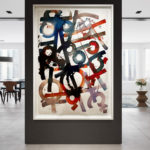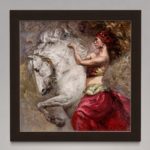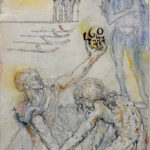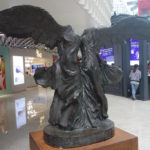Since 1878 Daum have been crafting world-renowned beauty in lead crystal using rare and ancient techniques. In 1906 Daum revived pâte de verre (glass paste), an ancient Egyptian method of glass casting, developing the method so that by the 1930s Daum’s window panels used pâte de verre for richness instead of leaded or painted glass. Pate de verre involves making a paste of glass that is applied to the surface of the mold, then fired. The big advantage to pate de verre is that it allows for precise placement of particular glass colors in the mold. Other ways of filling the mold often result in some shifting of glass from where it has been placed prior to firing, but the pate de verre process helps to control this shifting. Today Daum still uses this method to produce their exquisite creations.
“Dali’s contribution to the art of glassmaking is dominated by his collaboration with DAUM, which began in the middle of the 1960’s and lasted close to 20 years. From the outset, this collaboration was the fruit of Dali’s excellent personal relations with Jacques Daum, whose great aesthetic merit consisted in accepting without comment Dali’s wildest project models confided to him by the painter during his visits to Cadaques. Like that plastic bottle of oil found by Dali in 1968 stuck between two rocks during one of his hikes through the Cap de Creus: he gave it to Jacques Daum as it was, soiled by tar, and said “You will see, it is very beautiful. It is only necessary to add the snail”, and to choose as its title “L’important c’est la rose” (What is important is the rose). At the beginning of the 80’s it was “Venus de Milo hysterique”. This time Dali didn’t spare the archetypical Greek. Starting with an idea from one of his drawings from the 30s, Femme aux Tiroirs” (Woman with Drawers), he bent the Venus de Milo backwards, as if being ferociously pulled by the hair. The model was in a lamentable rubber, filthy and out of shape and cracked by dryness. Anybody would have thrown it in the garbage without hesitation. Sublimated to the transparency of glass, today these models by Daum are essential objects of surrealism whose incontestable beauty is recognized by all.”
~ – Robert & Nicolas Descharnes, “Le Dur et le Mou” (Catalogue Raisonne of Dali sculpture), Pg. 129.
Salvador DALI (1904-1989)
Debris of an Automobile Giving Birth to a Blind Horse Biting a Telephone (1988)
Green glass paste and bronze from DAUM Glassworks of Nancy, France
Hgt: 44.5cm
Edition of 850
Literature: Robert & Nicolas Descharnes, Catalogue Raisonne “Le Dur et Le Mou”, pg. 134, Ref #342
PRICE: on request
Salvador DALI (1904-1989)
Antediluvian Phonograph (1980)
Mauve and White glass paste from DAUM Glassworks of Nancy, France
Hgt: 37cm
Edition of 300
Literature: Robert & Nicolas Descharnes, Catalogue Raisonne “Le Dur et Le Mou”, pg. 135, Ref #347
PRICE: on request
Salvador DALI (1904-1989)
Fleur du Mal (Fleur of Evil- 1968)
Blue glass paste from DAUM Glassworks of Nancy, France (also violet of yellow-green)
Hgt: 37cm
Edition of 150
Literature: Robert & Nicolas Descharnes, Catalogue Raisonne “Le Dur et Le Mou”, pg. 130, Ref #326
PRICE: on request
Salvador DALI (1904-1989)
Malebranche Fish (1973)
Golden green-yellow glass paste from DAUM Glassworks of Nancy, France
Hgt: 41cm
Edition of 150
Literature: Robert & Nicolas Descharnes, Catalogue Raisonne “Le Dur et Le Mou”, pg. 132, Ref #332
PRICE: on request
Salvador DALI (1904-1989)
Venus de Milo with Drawers (1988)
Pale blue glass paste from DAUM Glassworks of Nancy, France
Hgt: 43cm
Edition of 850
Literature: Robert & Nicolas Descharnes, Catalogue Raisonne “Le Dur et Le Mou”, pg. 134, Ref #339
PRICE: on request
CONTACT:
Reed V. Horth
ROBIN RILE FINE ART
Miami, FL USA
www.robinrile.com
reed@robinrile.com
PH: (813) 340-9629
Skype: reed.v.horth
LinkedIn: www.linkedin.com/in/reedhorth
Facebook: www.facebook.com/robinrile











